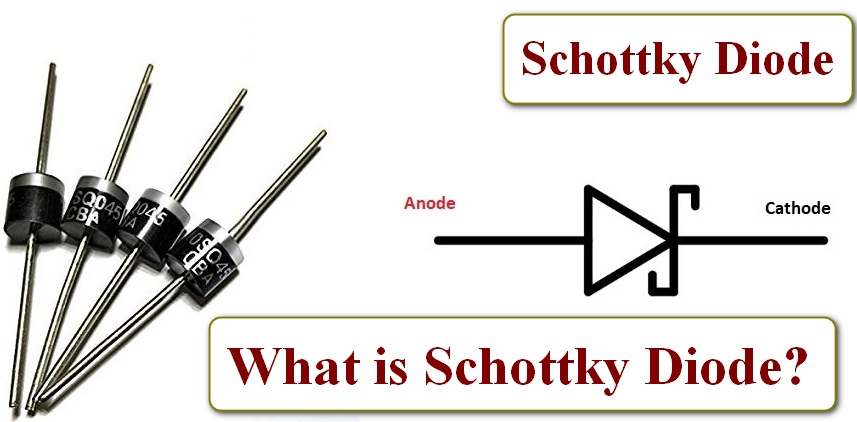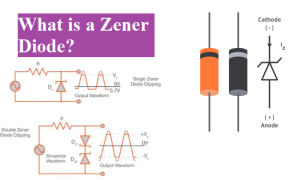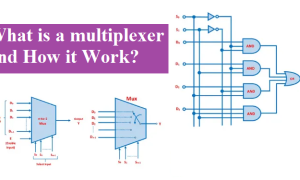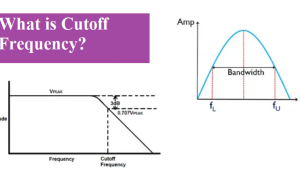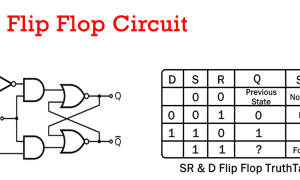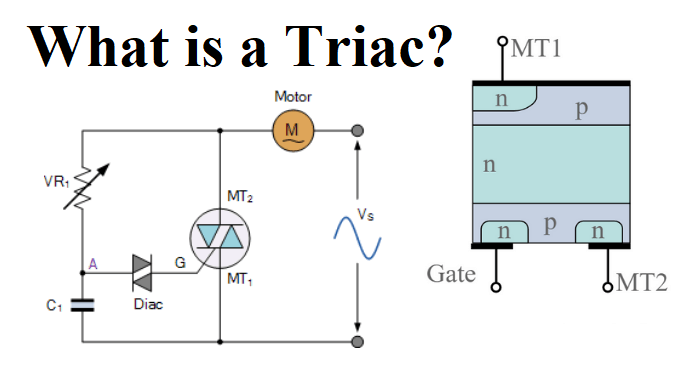In this tutorial we are going to lesson about different types of Diodes. Types of diode include Small Signal Diodes, Schottky Diodes, Zener Diodes, Tunnel Diodes, Light Emitting Diodes, Avalanche Diodes, etc. This is a note about different types of diode and basic operation.
The diode is a two terminal electronics device that conduct in only one direction. This means it is a unidirectional component. The basic use of diode is switching and rectifying an electrical signal. The diode is use in also various types of applications like communication, digital electronics and many more. The most of the diode is made of silicon but in other case the Ge (germanium) is also used.
Introduction Types of diode
The diode is two terminal electronics component that rectify the electrical signal. It is a unidirectional component that allows only one direction of flow of current. Most of the diode is made of silicon material but in some case the Germanium and Gallium Arsenide are use.
The terminal name of diode is anode and cathode. The anode terminal is positive and cathode is negative terminal of diode. The diode operation can be classified in two way o ways:
- If anode has higher potential than cathode, then we call the diode is Forward Bias and it allows current to flow in diode.
- If cathode has higher potential than anode, then we call the diode in Reverse Bias and it doesn’t allow current to flow through diode.
The different type of diode has different type of characteristic and that required a different voltage. For example the conventional PN junction silicon type of diode has 0.7V knee voltage and Germanium diode has 0.3V.
The main operation of diode is use in ratification. The rectification is a process in which the alternating current converts in direct current. Since the diode can only allow the positive half of the AC cycle and block the negative half of the AC cycle.
Different Types of Diodes
There are different types of diode. The types of diode is depends upon their construction and uses. The different types of diode are shown below:
Types of diode and symbol
The different type of diode is explained below. Let us now see about few common types of diodes one by one.

-
Small Signal Diode
This is a small device which is made of silicon or germanium type material but its characteristics are dependent on the doping material. It is use in general purpose diode applications parametric amplifiers, high switching and many more other type of applications. It is a conventional diode.
Peak Reverse Voltage (VPR) – It is the maximum reverse voltage of diode before it breaks down.
Reverse Current (IR) – when the diode is reverse bias a small current flow through it. This current is called reverse current.
Reverse Recovery Time – The time required for reverse current to fall down to IR.
-
Large Signal Diode
The large signal diode is a large PN region. It is use in reticulation process. In large signal diode the depletion width is increase with increase the reverse voltage. This diode is not suitable for high frequency.
The use of large signal diode is
- Power Supplies
- Rectifiers, converter,
- Inverters,
- Battery charging devices,
The performance of this diode is high so it is use in those place where the high voltage and current are required.
-
Zener Diode
It is most use full diode in voltage regulator that provides a stable voltage in circuit. It is operated in reverse direction and break down on the arrival of a certain voltage. When current passing through the resistor is limited, a stable voltage is generated. It is widely using in power supply for stable the voltage. The Zener diode is a passive element and firstly introduce by Clarence Zener in 1934,
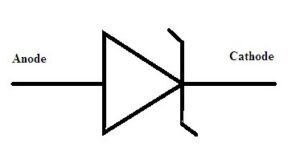
Applications of Zener Diode
There are some applications of a Zener diode are given below:
- It is used as a voltage regulate where the constant voltage required.
- over-voltage safeguarding
- It is used in clipping circuits
-
Light Emitting Diode (LED)
The LED is a light emitting diode is one of most standard types of diode. When the diode is connected in forward direction than the current start flow from the anode terminal to cathode terminal through the junction and generates the light. The LED diode is use to convert electrical energy into light energy. First production started in 1968. It is use in special type of application. Over the years, the cost of the LEDs has fall down. They are extremely power efficient LEDs as the main source of lighting in homes, , streets (for street lighting as well as traffic lights), offices, automobiles car, mobile phones etc.

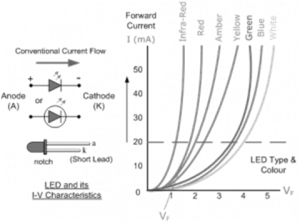
| Type of Semiconductor | Wavelength Distance | Color | Forward Voltage at 20mA |
| GaAS | 850-940nm | Infra-Red | 1.2v |
| GaAsP | 630-660nm | Red | 1.8v |
| GaAsP | 605-620nm | Amber | 2.0v |
| GaAsP: N | 585-595nm | Yellow | 2.2v |
| AIGaP | 550-570nm | Green | 3.5v |
| SiC | 430-505nm | Blue | 3.6v |
| GalnN | 450nm | White | 4.0v |
-
Constant Current Diodes
Another name of constant current diode is current regulating diode, current limiting diode or diode connector transistor. The use of constant current diode is to regulate the voltage at a particular current
-
Schottky Diode
The Schottky diode is an electronics component. It is a metal semiconductor diode with very small junction. Due to very small junction, it has low forward voltage. Forward voltage drop across junction 0.2v – 0.35v. This low forward voltage drop is the cause of fast switching speed and batter system efficiency. The barrier potential of Schottky diode is 0.4 volt.
The function of Schottky diode BA 157 in SMPS circuit is fast switching rectification of power supply converter inverter and freewheeling diode for diode for consumer.
It is used in various type of application like detector diode, mixer and radio frequency etc. it is useful in power because of low forward voltage drop due to this power losses become low as compare to PN junction diode. Also, it produces less unwanted noise compare to the normal p-n junction diode. Sometime it is also known as Schottky barrier diode or hot carrier diode, majority carrier device, hot-electron diode and barrier diode. it was invented by the German physicist Walter H. Schottky. It is a semiconductor diode not exactly the conventional PN junction diode. The conventional PN junction diode has two type of material but the Schottky diode has diffusion of semiconductor and metal. The metal use in this diode has high conductivity, basically the material use in Schottky diode are gold, chromium, tungsten, molybdenum, platinum, or certain silicates. Semiconductor material is silicon. The symbol of Schottky diode is as shown below.
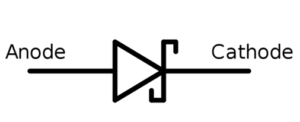
APPLICATIONS
There is a large Application of in electronics industry, use in various types of electronics products.
- Rectifier-It is use in rectifier circuit for convert alternating current to pulsating direct current.
- Voltage clamping –The forward voltage drop in PN junction diode of above 0.6V (Si) 0.2V (Ge) while the its voltage drop in forward region around 1mA is in the rage of 0.15 V to 0.46V which is good for voltage clamping application and protect the transistor saturation. It has higher current density.
- Reverse current and discharge protection–It has low forward voltage dope and less energy is wasted as heat. Due to this it is more efficient. In photovoltaic system to prevent discharging from battery to solar panel at night, called “blocking diodes”.
- RF mixer and detector diode– It has high switching speeds. Which is suitable for us in radio frequency application like RF mixer and detector
- In Solar cell applications, it is useful component.
- Power rectifier applications.
- Reverse current and discharge protection.
- It is used in Switched-mode power supplies.
7.Tunnel Diode
The tunnel diode is also called Eaki diode. The semiconductor diode has “negative resistance” characteristics. Property and this effect are called tunneling. The tunnel diode is a heavily doping of normal PN diode that is about 10 nm wide. Heavy doping is cause of broken band space, where the electron of the conduction band is more or less aligned with the valence band holes. The tunnel diode is a negative resistance element. The doping concentrations of P and N region in range of 1024 – 1025 m-3.
The symbol of tunnel diode is as shown below.

Advantages
The advantages of a tunnel are given below −
- This diode has high switching speeds.
- It is operating high frequencies range..
Disadvantages
The disadvantages of a tunnel are given below −
- It is low power semiconductor devices.
- Tunnel diodes are a slightly costly.
Applications
Applications of a tunnel diode are given below −
- Tunnel is used in relaxation oscillators.
- It is also used in microwave oscillators.
- It is used as Ultra high speed switching device.
- It is used as logic memory storage device in computer.
7. Varactor Diode
The varactor diode is reverse biased P-N junction whose capacitance is change in accordance with the applied reverse voltage across its terminal. The varactor diode is an electronics small component in which having two terminals one is anode and other is cathode. The diode can only work in one direction so it is called unidirectional component. In this tutorial we will discuss about variant of the diode.
“It is a variable capacitor type diodes whose capacitance value is changes with respect to voltage in a circuit and it is also known as varicap. It is a voltage dependent capacitor.”
SYMBOL OF VARACTOR DIODE

The symbol of varactor diode is shown below. It has two terminals one is anode terminal and other is cathode terminal. In the figure the one end show the diode and other end shows the two parallel lines that means conductive plates of the capacitor and the gap is dielectric material.
ADVANTAGES OF VARACTOR
The advantage of varactor is given below-
- It generates less noise as compared to the other diode.
- It is economical and reliable.
- The varactor is small in size and light in weight.
APPLICATIONS VARACTOR
Varactor is a import in our daily life. Some applications of varactor are given below.
- It is used in RF design arena and provides a method of varying the capacitance.
- It provides them with special capability due to which varactor diodes are used in the RF industry.
- It is possible to tune filters by using varactor diodes. Tracking the frequency of incoming received signals.
- Voltage-controlled oscillators are used for many applications and oscillators within a phase-locked loop are the major region. Voltage-controlled oscillators are present in almost all wireless receivers and radio.
People ask question about Types of diode
Which type of diode used in amplifier?
Small Signal Diodes are used in general purpose diode applications, high speed switching, parametric amplifiers and many other applications.
What is diodes and its types?
A diode is a two terminal electronics component device. It is made of semiconductor material most of the useable material is silicon because silicon has work high temperature and small leakage current as compare to other material. There are various types of diode which is explained above article.


